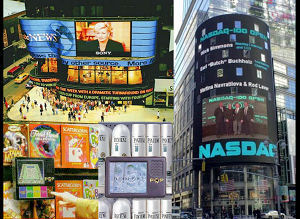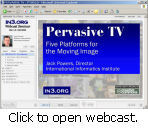The Interactive Future of Signs
By Jack Powers
Published: February 15, 1997
Why shouldn’t signs be interactive, too? Why do billboards, bus cards, and store signs all have to carry the same static information all of the time? Some years back, we studied the future of signs for a start-up funded by a giant consumer products company in New York. If you think about it long and hard, there’s no reason that the "pages" we see on signage shouldn’t be as animated and as interactive as the rest of new media.

A slide from IN3's executive briefings illustrating outdoor dynamic digital signage, anamorphic video and shelf TV.
The project we analyzed was a scheme to put large video monitors in grocery stores around America, but other firms have pioneered monitor-based advertising as well. Using today’s technology, the monitors carry ten or fifteen second animated advertisements--without sound--and can be updated continually via a modem-linked master control system. Think beyond today’s technology, though, and the sign of the future could easily become an integrated part of the interactive digital marketing environment.
In our analysis, we called the live displays "virtual signs" since they were not limited to the constraints of three-dimensional reality. Potential advertisers liked virtual signs because they were colorful and the ads moved, but a more important feature is built into the digital communications link: Any sign can be updated at any time.
Because each sign would be addressable, an advertiser could tune billboards for changing market. For example, signs in a mall could display Nike and Geritol ads for the AARP crowd in the morning, changing to McDonald’s ads at noon for lunchtime shoppers, becoming M&M ads at three o’clock when school lets out, and ending up with Clearasil ads in the evening while the mall rats hang about.
Most intriguing are the feedback possibilities, customizing the sign to local conditions so that the advertising tunes itself to the environment of the audience. If the temperature outside is below freezing, the ice cream ads automatically become hot chocolate commercials. If it starts snowing, snow shovels and sidewalk salt ads appear, along with travel ads for mid-winter beach vacations. If a motion sensor reads a big crowd in front of a subway ad, it starts to play the jingle or run a product-related trivia quiz. As display technology improves, the size of the signs would grow from TV screen dimensions to billboard size, and someday every billboard will be as changeable as the Sony Jumbotron in Times Square.
A General Motors sign along the highway in New Jersey could promote Cadillacs to Manhattan commuters during rush hour and then drop back to Buicks for the locals the rest of the time. Link the road side billboard system into the traffic department’s pavement sensors (as some traffic reporting web sites do) and the sign would know when its prospects were bumper-to- bumper, switching to a long copy version of the ad, a video of the car in action or even news and editorial material to hold the audience’s attention.
In a supermarket setting, the sign system could be linked to the inventory computer in the basement that processes the Universal Product Codes at each cash register. If the inventory unit notices that too few oranges have been sold and they’re about to go bad, a synthetically generated discount on oranges would flash up on all the signs in the produce department. Eventually inventory/marketing algorithms would balance stock-on-hand, store traffic, re-order points and perishability quotients to make the most of the retail process.
Of course, all of these protean signs would be linked to the Internet so that your intelligent agent software could notify you at your desktop when a quicky sale on oranges was posted or give you the results of the subway trivia contest. You could peek in at the department store specials before heading to the mall, and check the traffic on the highway near that GM billboard.
We had a great deal of fun brainstorming the evolution of signs in the digital age, but we’re seeing more and more virtual elements in today’s sign work. The old-fashioned slotted bulletin board that presents three different ads in the same space has been around for decades, but a new velcro-type sign panel makes it possible to easily update billboards with new data like the latest interest rate or this month’s lottery jackpot. Airline shuttle billboards in New York, Boston and Washington post the time of the next flight out in changing editorial copy, and MCI signs constantly report the amount of money their customers save over using AT&T.
The Paris subway has TV sets running commercials around the clock, and some U.S. transit advertising now incorporates customizable scrolling text displays. Bank windows in big cities contain exchange rate displays that are updated digitally, and every downtown has a stock brokerage office with scrolling market prices and news data. Even sports bars subscribe to digital scrolls of up-to-the-minute sports scores and news.
Virtual signs will not take over the world from today’s printed and painted displays anytime soon, but with just a few more technological leaps--and a huge infusion of interactive marketing vision-- it seems clear that signs, like all forms of graphic communications, have a digital future.\\

